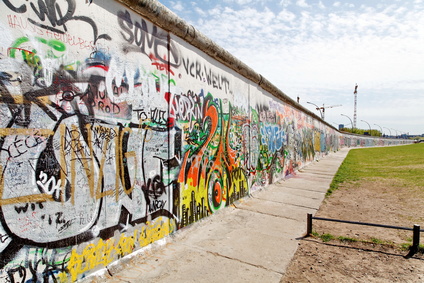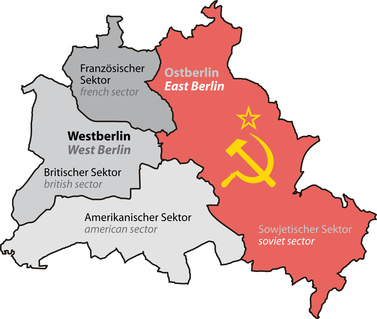
After World War II, Germany’s capital of Berlin was divided up into four occupied zones, one for each of the major victors of the war: the United States, the United Kingdom, France and Russia then known as the Soviet Union. (See map below) By 1949, Germany itself had been carved up into two distinct countries, East Germany or the DDR (Deutsche Democratische Republik) under the control of Soviet Russia and West Germany or the BRD (Bundesrepublik Deutschland). By the 1950s, West Germany was experiencing an economic boom or Wirtschaftswunder and many East Germans were leaving for the West. In response, the East German government built the Berlin wall or Berliner Mauer. The government claimed it was erected to protect its citizens from the fascist influences of West Germany. In reality, its main aim was to prevent any further citizens from leaving.
The Berlin wall was erected under cover of darkness on August 13, 1961. Most were caught off guard by it the next day and many people were separated from their families and jobs overnight. At first the Berlin wall was just a short barbed wire fence, but as people continued to try to cross over, the government fortified the structure in three successive waves of construction. To improve its effectiveness the wall was reinforced by electric fencing, newer concrete walls, trenches on either side, guard dogs and a large sand area known as the Death Strip with over 100 watchtowers housing soldiers with orders to kill on sight. For a fascinating series of short videos detailing the construction and history of the Berlin wall click here.
Throughout the nearly 30 years the wall stood, there were nine checkpoints at which individuals could cross to the other side. There were however numerous restrictions on movement, especially those attempting to enter into the West. The most famous of these checkpoints was named Checkpoint Charlie. Today a museum stands on this spot highlighting the ingenious ways in which individuals attempted to cross over, under and through the border without being caught.
Roughly 150 people died attempting to go through the Berlin wall. Many were shot, but some also drowned as they attempted to enter through sewer systems and rivers. To get a feel for what life was like just after the Berlin wall was built I highly recommend the film Der Tunnel. Based on the true story of a tunnel built in the early years of the Berlin wall, it is a thriller that really brings to life this historic era. For a trailer click here.
With other communist countries beginning to gain independence in 1989, East Germans took to the streets and churches to demonstrate their own desire for freedom. These peaceful protests came to be known as Montagsdemonstrationen as they took place on Mondays. Pressure on the East German government by its citizens built throughout that Fall, and on November 9 the official edict came down to open the border. That evening, thousands of East Germans or Ossis crossed over to West Germany. The atmosphere was jubilant with many West Germans or Wessis greeting them with champagne and embraces. Within days people began to hack away at the wall with hammers and took away pieces as keepsakes or souvenirs. These people came to be known as Mauerspechte or wall woodpeckers. Today only a small length of wall remains where tourists can visit and locals can be reminded of what was once a strong symbol of a divided nation.








